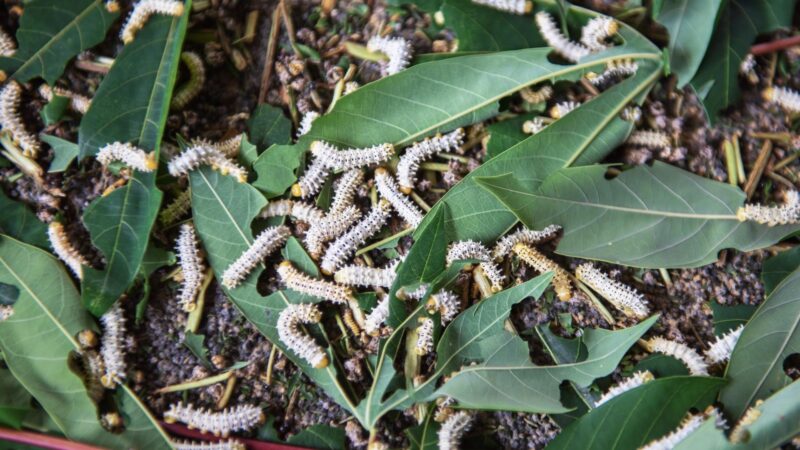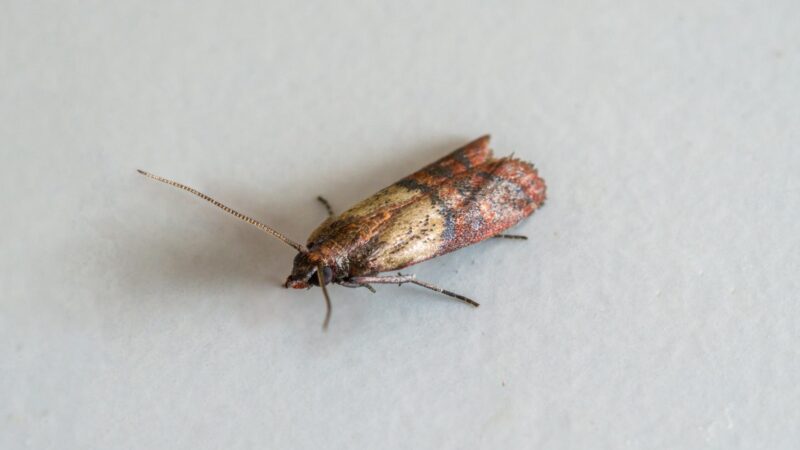White worms crawling up the walls are a very disturbing sight. Aside from that, seeing them doing nothing does not necessarily mean they are not causing any trouble. It’s likely that the worms, which are only creeping along ceilings and up walls, are Indianmeal moth larvae.
How to get rid of white worms crawling up the walls? Spraying them with soapy water or a vinegar solution can kill them. These white worms could be pinworms or larvae of clothes moths or pantry moths. If you are having a hard time identifying them, search your house, especially your closets and cupboards.
Scientifically known as Plodia interpunctella, Indianmeal moths are pantry moths that are usually active in the spring. They are widely distributed across the United States and are among the most commonly reported pests of stored grain and seed products. To avoid heavy infestations, this complete guide can help you.
What Causes White Worms in the House?

Maggots are brought inside the house by their adult version, the house fly. These flies are very attracted to food scraps, dead animals, garbage, human and animal feces, and other organic waste.
Females lay eggs on their food source, where the legless maggots emerge within 8-20 hours, especially during warmer months.
Pinworms, can enter a house once a household accidentally eats contaminated food from the outside or have direct contact with objects with pinworm eggs.
Pinworm infection can affect people of all ages, but the most common are little children or grade school students who put their dirty hands on their mouths.
Like maggots, Indianmeal moth larvae are brought inside the house by their adult counterparts.
These moths may hitchhike with you once you accidentally buy highly-infested food products, including grains, seeds, cereals, nuts, and some processed foods. This is common in poorly sanitized groceries and food stores.
What Are These Little White Worms?

The little white worms maybe fly larvae (also called maggots), pinworms, or Indianmeal moth larvae. Maggots go through three instars and can be between 3 and 12 mm long, from early-stage to full-grown larvae.
Despite having no legs, maggots can wiggle very slowly up to 50 feet until they transform into pupae.
Meanwhile, pinworms are worms that grow inside the intestines of a host, which usually are small children. These thread-like parasitic worms are about 1/2 inch long and are commonly seen in bowel movements.
Children can accidentally eat their eggs once they put their hands into their mouths after touching infected areas.
On the other hand, Indianmeal moth larvae are about 1/2 inch long and have 5 pairs of prolegs and 3 pairs of thoracic legs.
They are commonly seen crawling on walls and ceilings searching for places where they can transform into pupae. These larvae can also be yellowish or pink, depending on their food source.
Related: White Worms in the House Crawling up the Walls | Identification and Control Guide
Where Do Indianmeal Moth Larvae Come From?
Indianmeal moth larvae come from eggs. Just like butterflies and other moths, these species undergo complete metamorphosis or four life stages – egg, larva, pupa, and adult.
During warm weather, their complete life cycle is within six to eight weeks. On average, it takes about 55 days before eggs can become adults.
Where Do Indian Meal Moths Lay Eggs?
Indianmeal moths lay eggs on the upper surface of seeds, dried pet food, dried fruits, or similar food materials. Depending on the weather, the eggs will start to hatch within 2 to 14 days, and moth larvae will emerge.
A single female can lay between 60 and 300 eggs, either one by one or in groups between 12 and 30.
How Long Do Indianmeal Moth Larvae Live?
Indianmeal moth larvae have 5-7 seven larval instars, and it may take 4 to 5 weeks before they become mature. These white worms will have a slow growth if food is insufficient and if the weather will not cooperate.
While feeding, they will form a cocoon until they reach the pupal stage, which usually lasts for two weeks.
Are Indian Meal Moths Harmful?

Indian meal moths of all stages are not directly harmful to humans and pets. Adults don’t bite or sting and don’t carry transmittable diseases. In fact, they rarely feed.
Instead, they mate, and females lay eggs throughout their lives. But then, they contaminate food, which is usually no longer suitable for eating.
How Serious Are Indian Meal Moths?
Adult Indian meal moths and their larvae are considered the most serious pests of stored grain products. Their grayish-white eggs are only 0.3 to 0.5 mm. in length and are laid on the grain surface without being noticed.
Once larvae become mature, they will slowly climb to other grain shelves and pupate.
What Would Happen If My Dog Ate Indianmeal Moth Larvae?

Nothing bad will happen to your dog after eating Indianmeal moth larvae, and this also applies to humans. These white worms don’t have poison and will not make you sick when accidentally swallowed.
Regardless of the life stage, moths are very likely to die inside a body. But of course, no one wants to eat creepy worms.
Signs of an Indianmeal Moth Infestation
Unfortunately, it is not very easy to detect the early stages of an Indianmeal moth infestation. Their eggs are microscopic and are only found inside the grains.
Matured moth larvae leave the infested food before entering the pupal stage. To help you out, here are the signs that Indianmeal moths are infesting your home:
1. Presence of Adult Indianmeal Moths
Adult Indianmeal moths are about 0.5 inches (12.7 mm) long when at rest and have an average wingspan of about 0.6 inches (16 mm). They have three pairs of legs, a pair of wings, and a red-brown or gray head and thorax.
The outer portion of their front pair of wings is coppery, while the inner part is usually silver or gray.
Indianmeal moths do fly but usually in a zigzag pattern rather than in a straight path. They are also very attracted to light, which means that you may see them in your living room, lighted bedroom, kitchen, and storage areas, but away from food sources. This is also why they are commonly mistaken for clothes moths.
2. Remains of Indianmeal Moth Pupae
Indianmeal moth pupae don’t feed but rather grow inside a cocoon until they become adults. During this stage, they are mostly away from the infested area. This is also why removing an infestation is very challenging.
Nevertheless, you may spot some pupal case remains on the floor, around cupboards, etc.
3. Damaged food product packages
Indianmeal moth larvae cannot chew through food packages but they can still enter through very tiny holes or at the seam. This means that even unpacked foods can still have eggs in them, especially if they have been stored for a long time. This usually happens when there is an overstock problem.
4. Presence of Indianmeal Moth Larvae
The mere presence of Indianmeal moth larvae in almost every area is a very clear sign that there is already an infestation. But more importantly, you can see these white worms on the surface of grains and seeds eating as much as they can. Along with them are accumulated eggshells, cast skins, and fecal pellets.
How to Get Rid of Indianmeal Moth Larvae?
Since Indianmeal moth larvae feed on food products, using insecticides is not recommended. But because they don’t carry viruses, there are times when you can still save the food, especially if you are not selling them.
Here are some tips to get rid of Indianmeal moth larvae, along with some preventive measures:
- Examine all stored food products that may have been exposed to the infestation. This includes grains, cereal, seeds, biscuits, and dried pet foods.
- Include those that are still in sealed packs and the previously-opened ones.
- For slightly-infected foods, heating them in the oven at 130-150°F (54.4-65.5°C) for 30 minutes can kill the eggs and larvae.
- Alternatively, place them in a deep freezer at 0°F (-18°C) for 7-10 days.
- If the infestation is very severe, you have no choice but to throw them away.
- To help prevent Indianmeal moth larvae, check the packaging date of food products before buying them. The earlier the date is, the higher the chance of having white worms inside.
- Check for silken threads, webbing, and droppings, especially near the seams of packages.
- Don’t buy food products with damaged packages or a broken seal.
- Don’t buy food items that you have to store for a long time, especially during summer.
- Transfer purchased items to metal or plastic containers with tight-fitting lids. For easier inspection, glass might be a better choice.
- Don’t allow food scraps to accumulate in your cupboard or nearby areas.
- Don’t ignore adult Indianmeal moths. Place non-toxic sticky traps such as Dr. Killigan's Premium Pantry Moth Traps with Pheromones Prime around your kitchen.
How Do I Get Rid of White Worms on My Ceiling?
The white worms on your ceiling are very likely to be Indian meal moth larvae. You may not see them feeding on grains, but they will soon become adults that can later contaminate your pantry food.
To avoid further problems, here are some ways to get rid of those white worms crawling on your ceiling:
- Get a vacuum cleaner and suck them to death. Throw away the vacuum bag and wash your hands.
- Spray them with a vinegar solution or soapy water. Using insecticides is not necessary.
- For easier cleaning, use a brush with a long handle such as Lalafancy Shower Brush Scrubber with Long Extendable Handle .
- Some larvae may fall to various surfaces. To make sure you have killed all of them, mop the floor meticulously and clean all the nearby surfaces.
- Inspect your dried dog food, cereals, and similar food products on your cupboard.
- Remove everything from your cupboard and clean it thoroughly inside and out.
How Do You Get Rid of Moth Larvae on Walls?
Two types of moth larvae can be on your walls – pantry moth larvae and clothes moth larvae. They may seem to be look-alikes, but they differ a lot in terms of food sources.
But regardless of where the wall is, getting rid of moth larvae is somehow similar to the steps in removing them from your ceiling:
- Spray the wall with soapy water or a vinegar solution. Note, however, that some wall materials are not tolerant of vinegar.
- Brush the wall and floor thoroughly and vacuum it after drying.
- If larvae are on your bedroom wall, check your closets for clothes moths and eliminate them.
- If larvae are on your kitchen wall, inspect your pantry shelves and clean them. Additional details are explained below.
Does Vinegar Kill Moth Larvae?
Vinegar can kill moth larvae in contact and even the eggs. Mix one part of vinegar with one part of water. Then, spray the vinegar solution on grains, seeds, or any infested area and scrub them.
This strategy is effective but can be time-consuming. Vinegar can also damage certain surfaces, such as hardwood floors.
List of Sources
Sanchez-Arroyo, H., Capinera, J. L. (2020). House fly. University of Florida.
Rutschky, C. W., Calvin, D. (2017). Indian Meal Moth. PennState Extension.
Johnson, D. (2009). Insect Pests of Stored Grain: Indianmeal Moth. University of Kentucky.
Indianmeal Moth, Plodia interpunctella. Oklahoma State University.
Subramanyam, B. Indian Meal Moth – What You Need to Know. Kansas State University.
- How to Get Rid of Cockroaches? | Proven Strategies & Solutions! - June 24, 2023
- Powerful Homemade Wasp and Bee Sprays (with Recipes) - March 4, 2023
- Crazy Ants Invasion | Eradicate & Prevent Unwanted Guests - February 24, 2023
